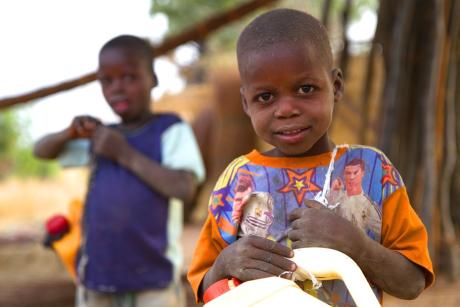
Bed nets like this one are commonly used to help prevent malaria in low and middle income countries. Photo credit: Department of Foreign Affairs and Trade, via Wikipedia Commons.
Published February 16, 2017, last updated on October 12, 2017 under Voices of DGHI
By Jane Fieldhouse and Julia Xu, 1st-year MSc-GH students
In a lecture last fall, Dr. Steve Taylor, assistant professor of medicine and global health, pointed out that while the number of deaths from severe malaria globally is very large, the proportion of malaria infections that result in death is actually quite small. It is due to the sheer magnitude of the burden of malaria in endemic countries that malaria kills so many people every year.
Decreasing the rate of malarial infections in endemic regions, therefore, would have a dramatic effect on the reduction of mortality from the disease. As students working in global health, we have this aerial view of the problem. We see the modes of transmission, the areas where we can intervene and the scope of the problem across communities and countries. But let’s look at it from the perspective of a member of a community suffering from endemic malaria: What do you think he understands about this terribly high burden of disease? What does she likely see “on the ground”?
Dr. Taylor recommended The Fever, a book by science journalist Sonia Shah, in which Shah describes how malaria parasites have shaped human history, geography and health for thousands of years. Shah also gave a TED Talk in 2013, “3 Reasons We Still Haven’t Gotten Rid of Malaria,” in which she considers why it has been so challenging to control malaria given that we know how to prevent and treat it. She cites the microbiological challenges posed by the parasite itself as well as the vector, the economic and political challenges existing within the highest-burden countries, and a third and major challenge: culture.
Within the communities most affected by malaria, she argues, the sheer incidence of the disease is so huge and the relative number of deaths so small that it has rendered the disease commonplace. Shah likens the cultural understanding of malaria in endemic areas to the Western cultural understanding of flu or cold. She insinuates that us handing out bed nets as an intervention is equivalent to public health experts from Asia coming to us and handing out facemasks during our flu season.
While the example may be a little far-fetched, and in no way means to undermine the importance of prevention efforts in malaria-stricken countries, Shah raises a critical point that cultural acceptance and understanding must be considered when thinking about malaria control interventions. This topic was raised in the article, “Global Health System: Linking Knowledge with Action—Learning from Malaria,” by Keusch et al. The article states that developing malaria prevention tools and delivering those services to low-income countries is particularly challenging because efforts to understand and combat malaria are frequently detached from efforts to deliver interventions.
I (Jane) can draw upon my own experiences in a village in Benin to demonstrate how malaria interventions may not align with local beliefs or understandings of malaria. If you ask anyone in that village, child or adult, how a person “gets” malaria, the response is typically “from too much sun or too much red palm oil.”
Even after teaching the community that mosquitos are the true vector and that sun exposure has nothing to do with malaria, everyone was still convinced the sun and palm oil play a significant role. In fact, any time someone felt slightly under-the-weather or fatigued, friends and family quickly labeled it malaria, though the “diagnosis” did not seem to faze anyone. Despite the local understanding of malaria, many households in Benin had insecticide-treated bed nets and knew they were supposed to sleep under them. Given the belief that malaria is caused by the sun, however, one has to wonder why the population in that village is sleeping under the mosquito nets.
This challenge highlighted by Shah and Keusch should be viewed with particular interest and embraced by our generation of global health professionals. Global health as a field is now more interdisciplinary than ever, and it is up to us to incorporate what we learn from our courses and our fieldwork and think outside of the box to ask and answer these tough, nuanced questions.
For malaria, some questions might revolve around how we can develop culturally relevant concepts of malaria transmission to aid in prevention and control, or how we can build community-based prevention efforts that integrate into existing cultural practices.
Dr. Taylor also mentioned in his talk that the eradication of malaria from developed nations coincided with their economic development. Perhaps the same will happen someday for the malaria-endemic countries of the world, but then again, the gap between rich and poor is widening. We can’t wait for the gap to close while hundreds of thousands of people die of a preventable and treatable disease. We need to learn from the successes and failures of past interventions and create new solutions.
This blog post was originally published on the class blog for the Fall 2016 Global Health Challenges class and was republished with permission from the authors.


